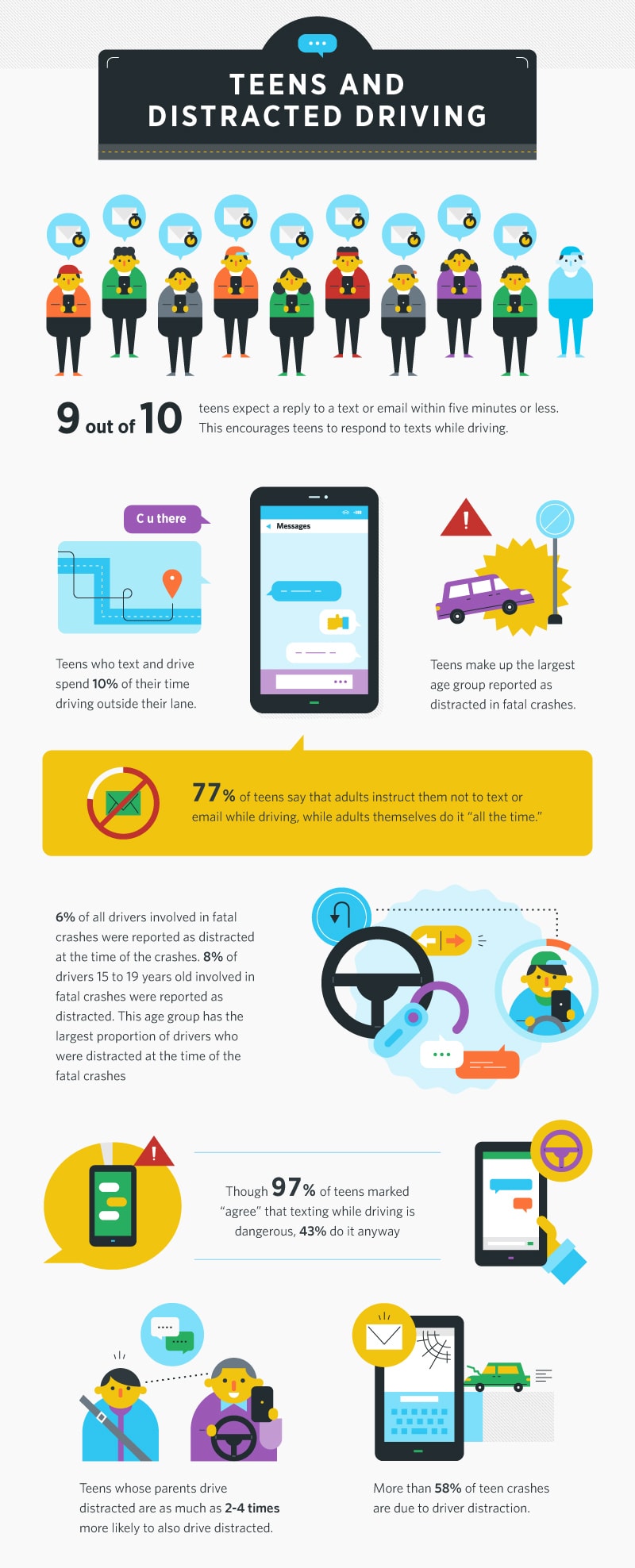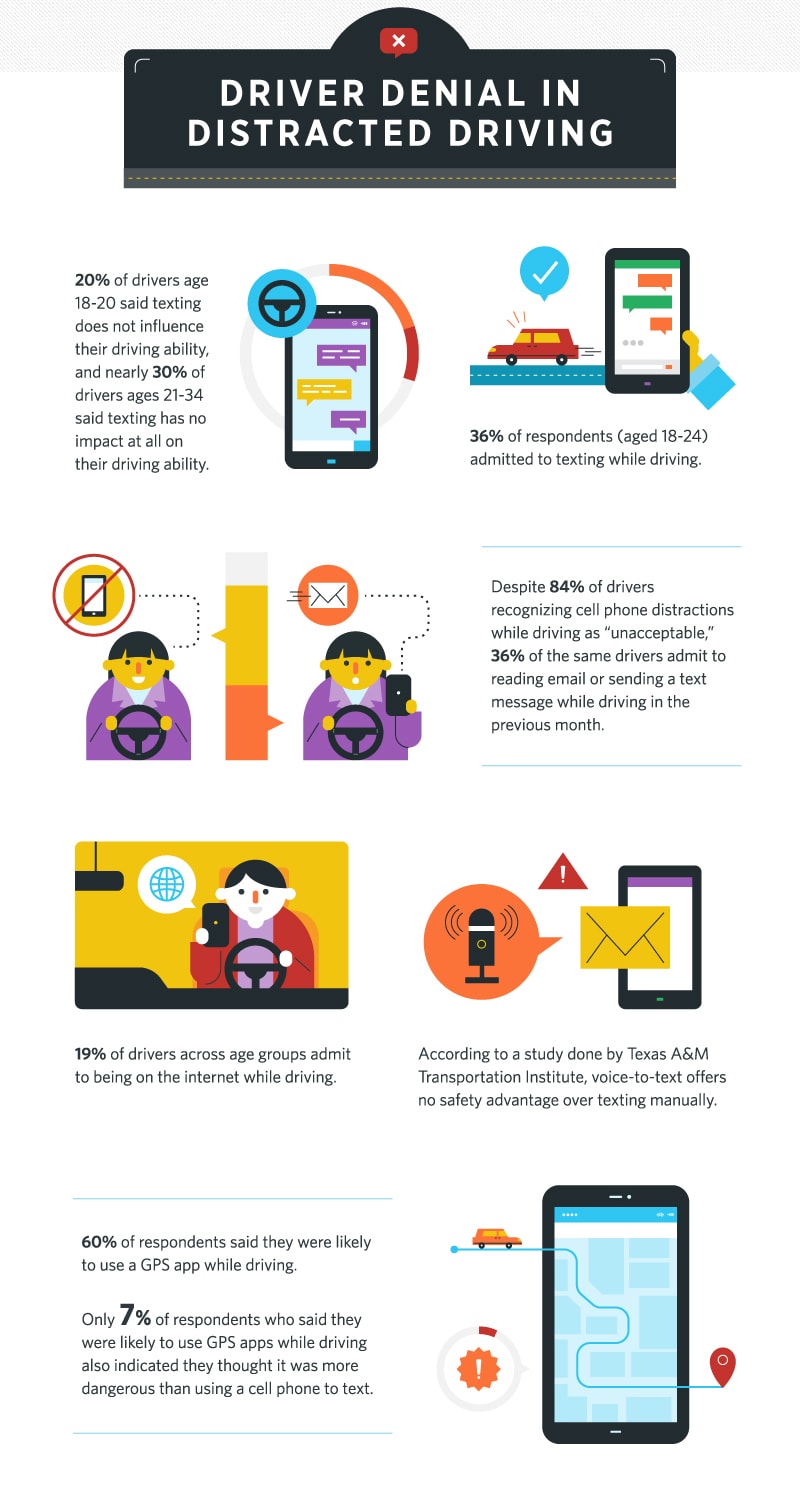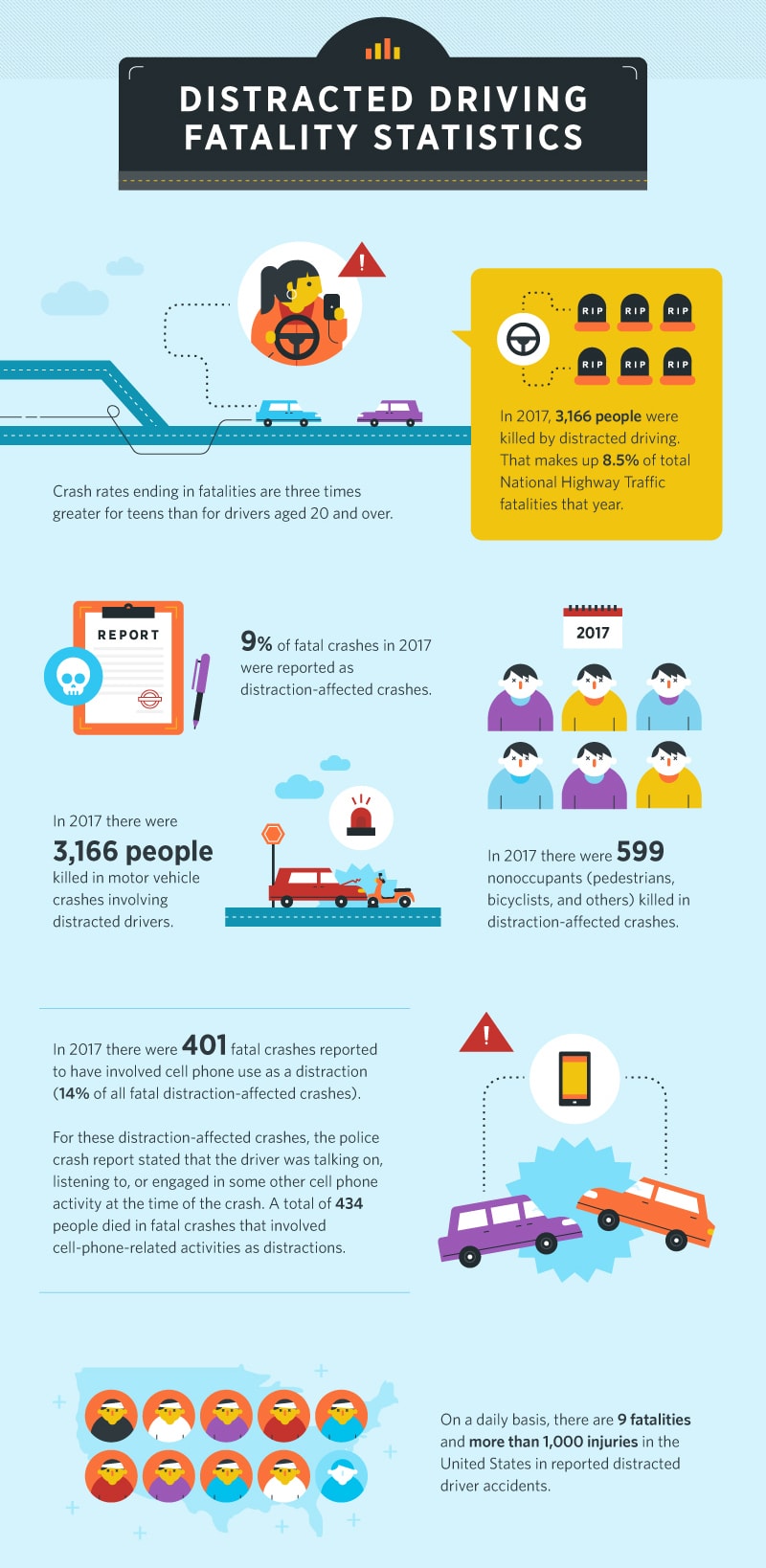34 Texting and Driving Statistics That Will Make You Put Your Phone Down

Updated April 17, 2024
In this day and age, Americans are highly aware of the perils of texting and driving. Still — despite most people acknowledging the dangers of sending texts taking phone calls, and checking email while driving — many people choose to do so anyway.
As of 2024, 49 states, Washington D.C., Puerto Rico, Guam, the Northern Mariana Islands and the U.S. Virgin Islands have altogether banned texting while driving. Nevertheless, distracted driving accidents at the hands of technology continue to be an issue. Even though the stats on cellphone use while driving are thought to be under-reported by authorities, the data on distracted driving says it all.
Here at SlickText, we believe mass texting is the key to the future of marketing and professional large-scale communications. With that said, texting must be done responsibly. Take a look at these 34 texting and driving statistics that show how dangerous cell phone use while driving actually is.
Teenage Texting and Driving Statistics
2024 teenage texting and driving statistics show that not enough teens are accepting that it’s impossible to safely operate a motor vehicle and look at your phone at the same time. On top of that, average screen time is increasing with younger generations. Here are some stats on teens and distracted driving that you should know.
- Research on texting habits shows that people respond to text messages almost instantly. In fact, 9 out of 10 teens expect a reply to a text or email within five minutes or less. This encourages teens to respond to texts while driving.
- Teens who text and drive spend 10% of their time driving outside their lane.
- Teens make up the largest age group reported as distracted in fatal crashes.
- 77% of teens say that adults instruct them not to text or email while driving, while adults themselves do it “all the time.”
- Six percent of all drivers involved in fatal crashes were reported as distracted at the time of the crashes. Eight percent of drivers 15 to 19 years old involved in fatal crashes were reported as distracted. This age group has the largest proportion of drivers who were distracted at the time of the fatal crashes.
- Though 97% of teens marked “agree” that texting while driving is dangerous, 43% do it anyway.
- Teens whose parents drive distracted are as much as 2 to 4 times more likely to also drive distracted.
- More than 58% of teen crashes are due to driver distraction.

Shocking Distracted Driving Statistics
Even if you acknowledge that texting and driving is a problem, these statistics might shock you. There is no nationwide texting or phone usage ban associated with operating a motor vehicle. That being said, some states have passed laws banning the act.
- As of 2024, 36 states and D.C. have banned cell phone use, both texting, and calling, by novice drivers.
- As of 2024, 25 states and D.C. have banned cell phone use for school bus drivers.
- 38% of respondents (aged 18-24) rated their knowledge of their state’s own laws about texting & driving as “very familiar.”
- 55% of these same respondents thought it was illegal to text while driving in all 50 states.
- Texting while driving makes a crash up to 23 times more likely.
- 48% of those surveyed said they thought driving under the influence of alcohol was about as dangerous as texting and driving.
- According to the National Occupant Protection Use Survey, women are more likely than men to use their cell phones while driving.
- According to research from the AAA Foundation for Traffic Safety, voice-activated in-car technologies undermine driver attention to a dangerous degree.
- During the daytime, more than 800,000 drivers use phones behind the wheel.
- If you use a cell phone, you are 5.36 times more likely to get into an accident than undistracted drivers.
- Driving and talking on a cell phone results in the same impairment as driving intoxicated at the legal blood-alcohol limit of 0.08%.
- The minimal time of attention a texting driver takes away from the road is five seconds. This equals the length of a standard football field spent looking away from the road if the driver is traveling at 55 mph.
Driver Denial in Distracted Driving
Though they recognize the dangers of distracted driving, many people have trouble coming to terms with their own driving habits. This is one of the leading causes of the most alarming 2024 texting and driving statistics out there. Take a look.
- Despite 84% of drivers recognizing cell phone distractions while driving as “unacceptable,” 36% of the same drivers admit to reading email or sending a text message while driving in the previous month.
- 20% of drivers aged 18-20 said texting does not influence their driving ability, and nearly 30% of drivers ages 21-34 said texting has no impact at all on their driving ability.
- 36% of respondents (aged 18 to 24) admitted to texting while driving.
- Of those who admitted to texting while driving, 51% said they were “very” or “extremely” familiar with their state’s texting and driving laws.
- 60% of respondents said they were likely to use a GPS app while driving.
- Only 7% of respondents who said they were likely to use GPS apps while driving also indicated they thought it was more dangerous than using a cell phone to text.
- 19% of drivers across age groups admit to being on the internet while driving.
- According to a study done by Texas A&M Transportation Institute, voice-to-text offers no safety advantage over texting manually.

Texting and Driving Death Statistics
The correlation between distracted driving and road accidents resulting in fatalities is strong. You may have asked yourself “How many people die from texting and driving?” Here are some fatality statistics to make you think twice about looking at your phone when you’re behind the wheel.
- Crash rates ending in fatalities are three times greater for teens than for drivers aged 20 and over.
- In 2022, 3,308 people were killed by texting or other distractions while driving. That makes up 7.8 percent of total National Highway Traffic fatalities that year.
- Eight percent of fatal crashes in 2022 were reported as distraction-affected crashes.
- The latest research reveals that 289,310 people were injured in motor vehicle crashes involving distracted drivers in 2022.
- More than 18% of fatalities involving distracted drivers were non-occupants (pedestrians, bicyclists, and others) in 2022.
- In 2022, there were 368 fatal crashes reported to have involved texting as a distraction (12% of all fatal distraction-affected crashes). For these distraction-affected crashes, the police crash report stated that the driver was texting, talking on the phone, listening to music, or engaged in some other cell phone activity at the time of the crash.
- On a daily basis, there are nine fatalities and more than 1,000 injuries in the United States in reported distracted driver accidents.

Ways to Prevent Distracted Driving/Texting and Driving
The data says it all, but there are some ways you can prevent distracted driving.
- Turn off your notifications while driving to avoid unnecessary distractions.
- Pull over if you need to make a call or send a text.
- Install a phone holder in your car to keep your GPS at eye level while driving.
Seemingly small changes in your driving habits could be the difference between life and death. Commit to driving safely — your text messages might be important, but getting to your destination safely is even more important.
